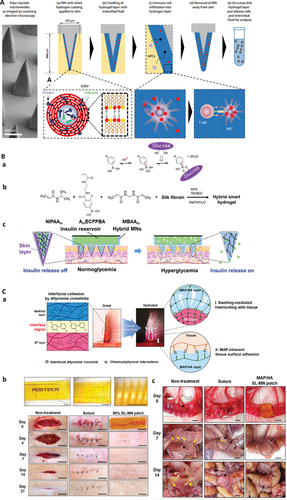AFM Review of Harvard Medical School Advanced Biological response multitasking Hydrogels in the New era of Biomedicine
QQ Academic Group: 1092348845
Detailed
[abstract].
Advanced forms of hydrogels have many inherent ideal properties and can be designed to have different structures and functions. In particular, bioresponsive multifunctional hydrogels can perform complex biological functions. These include in situ single cell methods, capture, analysis and release of living cells, and bionics of cell, tissue, and tumor-specific niches. They can operate with cells in the body and act as new drug delivery systems for diagnosis, treatment, vaccination and immunotherapy.
Recently, in a review of the hydrogel Advanced Functional Materials entitled Advanced Bioresponsive Multitasking Hydrogels in the New Era of Biomedicine, a team of Professor Michael R. Hamblin of the University of Johannesburg, Professor Rana Jahanban-Esfahlan of Tabriz Medical University and Professor Zohreh Amoozgar of Harvard Medical School summarized new methods and devices for immediate detection (POCT), microarrays, single / rare cell methods, artificial membranes, biomimetic modeling systems, nanomedicine doctors, and microneedle patches. The potential and application of each format are discussed critically, and some limitations are highlighted. Finally, people look forward to how hydrogels can make the integrated platform play a key role in cancer treatment, regenerative medicine, and the treatment of inflammatory, degenerative, genetic and metabolic diseases.
[guide to the main picture].

Figure 1.
Multitasking POCT hydrogel format.

Figure 2.
Multitasking hydrogel microarray.

Figure 3.
Hydrogels filled with nanopores for single molecule detection and sequencing.

Figure 4.
The multitasking hydrogel platform allows single cell capture and sequencing.

Figure 5.
A multitasking biological response hydrogel form for the capture and release of rare cells.

Figure 6.
Cellular bionics based on multitasking biological response hydrogels for loading, producing and delivering RNAi to target cells.

Figure 7.
Hydrogel-derived artificial cells capable of producing proteins, immobilization and communication.

Figure 8.
Multi-responsive artificial cells derived from hydrogels can be deformed and manipulated by robots for magnetic movement, cargo loading and transportation.

Figure 9.
Multitasking hydrogel for soft tissue regeneration.

Figure 10.
A hydrogel derived bionic model system for cell culture and a 3D dynamic porous mineralized matrix for bone regeneration.

Figure 11.
Nano doctors for vaccination and on-demand drug release.

Figure 12.
Multitasking hydrogel microneedle (MN) patch for the treatment and monitoring of different diseases.
[summary].
In recent years, it can be considered that biomedicine has entered a new era, characterized by the development of new methods, such as single-cell genomics , in situ and in vivo cell manipulation, and on-demand and command control of drug release. These methods have been explored not only to reveal the underlying molecular mechanisms of the disease, but also to identify new targets / markers, as well as new treatments and immunotherapies. These new methods can also improve the possibility of clinical transformation, which is a step towards personalized and accurate medicine.
This information is from the Internet for academic exchange only. if there is any infringement, please contact us to delete it immediately.
Advanced forms of hydrogels have many inherent ideal properties and can be designed to have different structures and functions. In particular, bioresponsive multifunctional hydrogels can perform complex biological functions. These include in situ single cell methods, capture, analysis and release of living cells, and bionics of cell, tissue, and tumor-specific niches. They can operate with cells in the body and act as new drug delivery systems for diagnosis, treatment, vaccination and immunotherapy.
Recently, in a review of the hydrogel Advanced Functional Materials entitled Advanced Bioresponsive Multitasking Hydrogels in the New Era of Biomedicine, a team of Professor Michael R. Hamblin of the University of Johannesburg, Professor Rana Jahanban-Esfahlan of Tabriz Medical University and Professor Zohreh Amoozgar of Harvard Medical School summarized new methods and devices for immediate detection (POCT), microarrays, single / rare cell methods, artificial membranes, biomimetic modeling systems, nanomedicine doctors, and microneedle patches. The potential and application of each format are discussed critically, and some limitations are highlighted. Finally, people look forward to how hydrogels can make the integrated platform play a key role in cancer treatment, regenerative medicine, and the treatment of inflammatory, degenerative, genetic and metabolic diseases.
[guide to the main picture].

Figure 1.
Multitasking POCT hydrogel format.

Figure 2.
Multitasking hydrogel microarray.

Figure 3.
Hydrogels filled with nanopores for single molecule detection and sequencing.

Figure 4.
The multitasking hydrogel platform allows single cell capture and sequencing.

Figure 5.
A multitasking biological response hydrogel form for the capture and release of rare cells.

Figure 6.
Cellular bionics based on multitasking biological response hydrogels for loading, producing and delivering RNAi to target cells.

Figure 7.
Hydrogel-derived artificial cells capable of producing proteins, immobilization and communication.

Figure 8.
Multi-responsive artificial cells derived from hydrogels can be deformed and manipulated by robots for magnetic movement, cargo loading and transportation.

Figure 9.
Multitasking hydrogel for soft tissue regeneration.

Figure 10.
A hydrogel derived bionic model system for cell culture and a 3D dynamic porous mineralized matrix for bone regeneration.

Figure 11.
Nano doctors for vaccination and on-demand drug release.

Figure 12.
Multitasking hydrogel microneedle (MN) patch for the treatment and monitoring of different diseases.
[summary].
In recent years, it can be considered that biomedicine has entered a new era, characterized by the development of new methods, such as single-cell genomics , in situ and in vivo cell manipulation, and on-demand and command control of drug release. These methods have been explored not only to reveal the underlying molecular mechanisms of the disease, but also to identify new targets / markers, as well as new treatments and immunotherapies. These new methods can also improve the possibility of clinical transformation, which is a step towards personalized and accurate medicine.
This information is from the Internet for academic exchange only. if there is any infringement, please contact us to delete it immediately.
- Previous£º Bioglass scaffold mate
- Next£º A Rising 2D Star: Nove


 Academic Frontier
Academic Frontier